Climate Variability and Mangrove Cover Dynamics at Species Level in the Sundarbans, Bangladesh
Abstract
:1. Introduction
2. Method
2.1. Study Area
2.2. Data Used in This Research
2.3. Trend Analysis of Climatic Variables
2.4. Analysis of Satellite Images to Identify the Changes in Mangrove Cover
2.5. Impacts of Climate Variability on Mangrove Cover Change
3. Results
3.1. Trend of Climatic Variables
3.2. Satellite Image Analysis
3.3. Relationship between Climate Variability and Mangrove Cover Change
4. Discussion
5. Conclusions
Author Contributions
Conflicts of Interest
References
- Ahmed, A.U.; Alam, M. Development of climate change scenarios with general circulation models. In Vulnerability and Adaptation to Climate Change for Bangladesh; Huq, S., Karim, Z., Asaduzzaman, M., Mahtab, F., Eds.; Springer: Dordrecht, The Netherlands, 1999; pp. 13–20. [Google Scholar]
- Mahadevia, K.; Vikas, M. Climate Change-Impact on the Sundarbans. Available online: https://scholar.google.com.au/scholar?q=Climate+change-impact+on+the+Sundarbans&btnG=&hl=en&as_sdt=0%2C5 (accessed on 12 December 2016).
- Agrawala, S.; Ota, T.; Ahmed, A.U.; Smith, J.; Van Aalst, M. Development and Climate Change in Bangladesh: Focus on Coastal Flooding and the Sundarbans; Organization for Economic Co-operation and Development (OECOD): Paris, France, 2003. [Google Scholar]
- Gilman, E.L.; Ellison, J.; Duke, N.C.; Field, C. Threats to mangroves from climate change and adaptation options: A review. Aqua. Botany 2008, 89, 237–250. [Google Scholar] [CrossRef]
- Eslami-Andargoli, L.; Dale, P.; Sipe, N.; Chaseling, J. Mangrove expansion and rainfall patterns in Moreton Bay, southeast Queensland, Australia. Estuar. Coast. Shelf Sci. 2009, 85, 292–298. [Google Scholar] [CrossRef]
- Field, C.D. Impact of expected climate change on mangroves. Hydrobiologia 1995, 295, 75–81. [Google Scholar] [CrossRef]
- Gilman, E. Assessing and managing coastal ecosystem response to projected relative sea-level rise and climate change. In Proceedings of the Prepared for the International Research Foundation for Development Forum on Small Island Developing States: Challenges, Prospects and International Cooperation for Sustainable Development. Contribution to the Barbados, Port Louis, Mauritius, 10–14 January 2005; p. 28. [Google Scholar]
- Snedaker, S.C. Mangroves and climate change in the Florida and Caribbean region: Scenarios and hypotheses. Hydrobiologia 1995, 295, 43–49. [Google Scholar] [CrossRef]
- Houghton, J.T.; Ding, Y.; Griggs, D.J.; Noguer, M.; van der Linden, P.J.; Dai, X.; Maskell, K.; Johnson, C. Climate Change 2001: The Scientific Basis; Cambridge University Press: Cambridge, UK; New York, NY, USA, 2001; p. 881. [Google Scholar]
- Duke, N.; Ball, M.; Ellison, J. Factors influencing biodiversity and distributional gradients in mangroves. Glob. Ecol. Biogeogr. Lett. 1998, 7, 27–47. [Google Scholar] [CrossRef]
- Ellison, J.C. How South Pacific mangroves may respond to predicted climate change and sea-level rise. In Climate Change in the South Pacific: Impacts and Responses in Australia, New Zealand, and Small Island States; Gillespie, A., Burns, W., Eds.; Springer: Dordrecht, The Netherlands, 2000; pp. 289–300. [Google Scholar]
- Gilman, E.; Ellison, J.; Coleman, R. Assessment of mangrove response to projected relative sea-level rise and recent historical reconstruction of shoreline position. Environ. Monitor. Assess. 2007, 124, 105–130. [Google Scholar] [CrossRef] [PubMed]
- Lovelock, C.E.; Ellison, J. Vulnerability of mangroves and tidal wetlands of the Great Barrier Reef to climate change. In Climate Change and the Great Barrier Reef: A Vulnerability Assessment; Johnson, J.E., Marshall, P.A., Eds.; Great Barrier Reef marine park authority and Australian Greenhouse Office: Townsville, Australia, 2007; pp. 237–269. [Google Scholar]
- Solomon, S. Climate Change 2007—The Physical Science Basis; Working Group I Contribution to the Fourth Assessment Report of the IPCC; Cambridge University Press: Cambridge, UK, 2007; Volume 4. [Google Scholar]
- Ghosh, M.K.; Kumar, L.; Roy, C. Mapping Long-Term Changes in Mangrove Species Composition and Distribution in the Sundarbans. Forests 2016, 7, 305. [Google Scholar] [CrossRef]
- McTainsh, G.; Iles, B.; Saffigna, P. Spatial and Temporal Patterns of Mangroves at Oyster Point Bay, South East Queensland, 1944–1983; Royal Society of Queensland: Brisbane, Australia, 1986; pp. 83–91. [Google Scholar]
- Saintilan, N.; Williams, R.J. Mangrove transgression into saltmarsh environments in south-east Australia. Glob. Ecol. Biogeogr. 1999, 8, 117–124. [Google Scholar] [CrossRef]
- Saintilan, N.; Wilton, K. Changes in the distribution of mangroves and saltmarshes in Jervis Bay, Australia. Wetl. Ecol. Manag. 2001, 9, 409–420. [Google Scholar] [CrossRef]
- McKee, K.L. Global Change Impacts on Mangrove Ecosystems; U.S Department of Interior, U.S. Geological Survey, U.S.: Reston, VA, USA, 2004.
- Jagtap, T.G.; Nagle, V.L. Response and adaptability of mangrove habitats from the Indian subcontinent to changing climate. AMBIO A J. Hum. Environ. 2007, 36, 328–334. [Google Scholar] [CrossRef]
- Iftekhar, M. Forestry in Bangladesh: An overview. J. For. 2006, 104, 148–153. [Google Scholar]
- Bhowmik, A.K.; Cabral, P. Cyclone Sidr Impacts on the Sundarbans Floristic Diversity. Earth Sci. Res. 2013, 2, 62. [Google Scholar] [CrossRef]
- Chowdhury, M.Q.; De Ridder, M.; Beeckman, H. Climatic Signals in Tree Rings of Heritiera fomes Buch.-Ham. in the Sundarbans, Bangladesh. PLoS ONE 2016, 11, e0149788. [Google Scholar] [CrossRef] [PubMed]
- Spalding, M. World Atlas of Mangroves; Earthscan: London, UK, 2010; p. 319. [Google Scholar]
- Ghosh, A.; Schmidt, S.; Fickert, T.; Nüsser, M. The Indian Sundarban Mangrove Forests: History, Utilization, Conservation Strategies and Local Perception. Diversity 2015, 7, 149–169. [Google Scholar] [CrossRef]
- Iftekhar, M.; Islam, M. Managing mangroves in Bangladesh: A strategy analysis. J. Coast. Conserv. 2004, 10, 139–146. [Google Scholar] [CrossRef]
- Giri, C.; Pengra, B.; Zhu, Z.; Singh, A.; Tieszen, L.L. Monitoring mangrove forest dynamics of the Sundarbans in Bangladesh and India using multi-temporal satellite data from 1973 to 2000. Estuar. Coast. Shelf Sci. 2007, 73, 91–100. [Google Scholar] [CrossRef]
- Green, E.P.; Clark, C.D.; Mumby, P.J.; Edwards, A.J.; Ellis, A. Remote sensing techniques for mangrove mapping. Int. J. Remote Sens. 1998, 19, 935–956. [Google Scholar] [CrossRef]
- Hirano, A.; Madden, M.; Welch, R. Hyperspectral image data for mapping wetland vegetation. Wetlands 2003, 23, 436–448. [Google Scholar] [CrossRef]
- Kovacs, J.M. Assessing mangrove use at the local scale. Landsca. Urban Plan. 1999, 43, 201–208. [Google Scholar] [CrossRef]
- Kovacs, J.M.; Wang, J.; Flores-Verdugo, F. Mapping mangrove leaf area index at the species level using IKONOS and LAI-2000 sensors for the Agua Brava Lagoon, Mexican Pacific. Estuar. Coast. Shelf Sci. 2005, 62, 377–384. [Google Scholar] [CrossRef]
- Sader, S.A.; Ahl, D.; Liou, W.-S. Accuracy of Landsat-TM and GIS rule-based methods for forest wetland classification in Maine. Remote Sens. Environ. 1995, 53, 133–144. [Google Scholar] [CrossRef]
- Giri, S.; Mukhopadhyay, A.; Hazra, S.; Mukherjee, S.; Roy, D.; Ghosh, S.; Ghosh, T.; Mitra, D. A study on abundance and distribution of mangrove species in Indian Sundarban using remote sensing technique. J. Coast. Conserv. 2014, 18, 359–367. [Google Scholar] [CrossRef]
- Long, B.G.; Skewes, T.D. A technique for mapping mangroves with Landsat TM satellite data and geographic information system. Estuar. Coast. Shelf Sci. 1996, 43, 373–381. [Google Scholar] [CrossRef]
- Franklin, J. Discrimination of tropical vegetation types using SPOT multispectral data. Geocarto Int. 1993, 8, 57–63. [Google Scholar] [CrossRef]
- Pasqualini, V.; Iltis, J.; Dessay, N.; Lointier, M.; Guelorget, O.; Polidori, L. Mangrove mapping in North-Western Madagascar using SPOT-XS and SIR-C radar data. In Diversity and Function in Mangrove Ecosystems; Dodd, R.S., Ed.; Springer: Dordrecht, The Netherlands, 1999; pp. 127–133. [Google Scholar]
- Li, S.; Wang, H.; Jiang, X. Application of CBERS-1 CCD in the mangrove Remote Sensing Survey. Mar. Sci. Bull. 2003, 22, 30–35. [Google Scholar]
- Vaiphasa, C.; Skidmore, A.K.; de Boer, W.F. A post-classifier for mangrove mapping using ecological data. ISPRS J. Photogramm. Remote Sens. 2006, 61, 1–10. [Google Scholar] [CrossRef]
- Wang, L.; Sousa, W.P.; Gong, P.; Biging, G.S. Comparison of IKONOS and QuickBird images for mapping mangrove species on the Caribbean coast of Panama. Remote Sens. Environ. 2004, 91, 432–440. [Google Scholar] [CrossRef]
- Wang, L.; Sousa, W.; Gong, P. Integration of object-based and pixel-based classification for mapping mangroves with IKONOS imagery. Int. J. Remote Sens. 2004, 25, 5655–5668. [Google Scholar] [CrossRef]
- Kirui, K.B.; Kairo, J.G.; Bosire, J.; Viergever, K.M.; Rudra, S.; Huxham, M.; Briers, R.A. Mapping of mangrove forest land cover change along the Kenya coastline using Landsat imagery. Ocean Coast. Manag. 2013, 83, 19–24. [Google Scholar] [CrossRef]
- Myint, S.W.; Giri, C.P.; Wang, L.; Zhu, Z.; Gillette, S.C. Identifying mangrove species and their surrounding land use and land cover classes using an object-oriented approach with a lacunarity spatial measure. GISci. Remote Sens. 2008, 45, 188–208. [Google Scholar] [CrossRef]
- Foody, G.M. Thematic map comparison. Photogramm. Eng. Remote Sens. 2004, 70, 627–633. [Google Scholar] [CrossRef]
- Foody, G.M. Harshness in image classification accuracy assessment. Int. J. Remote Sens. 2008, 29, 3137–3158. [Google Scholar] [CrossRef]
- McKee, K.L. Soil physicochemical patterns and mangrove species distribution—Reciprocal effects? J. Ecol. 1993, 477–487. [Google Scholar] [CrossRef]
- Islam, S.N.; Gnauck, A. Mangrove wetland ecosystems in Ganges-Brahmaputra delta in Bangladesh. Front. Earth Sci. China 2008, 2, 439–448. [Google Scholar] [CrossRef]
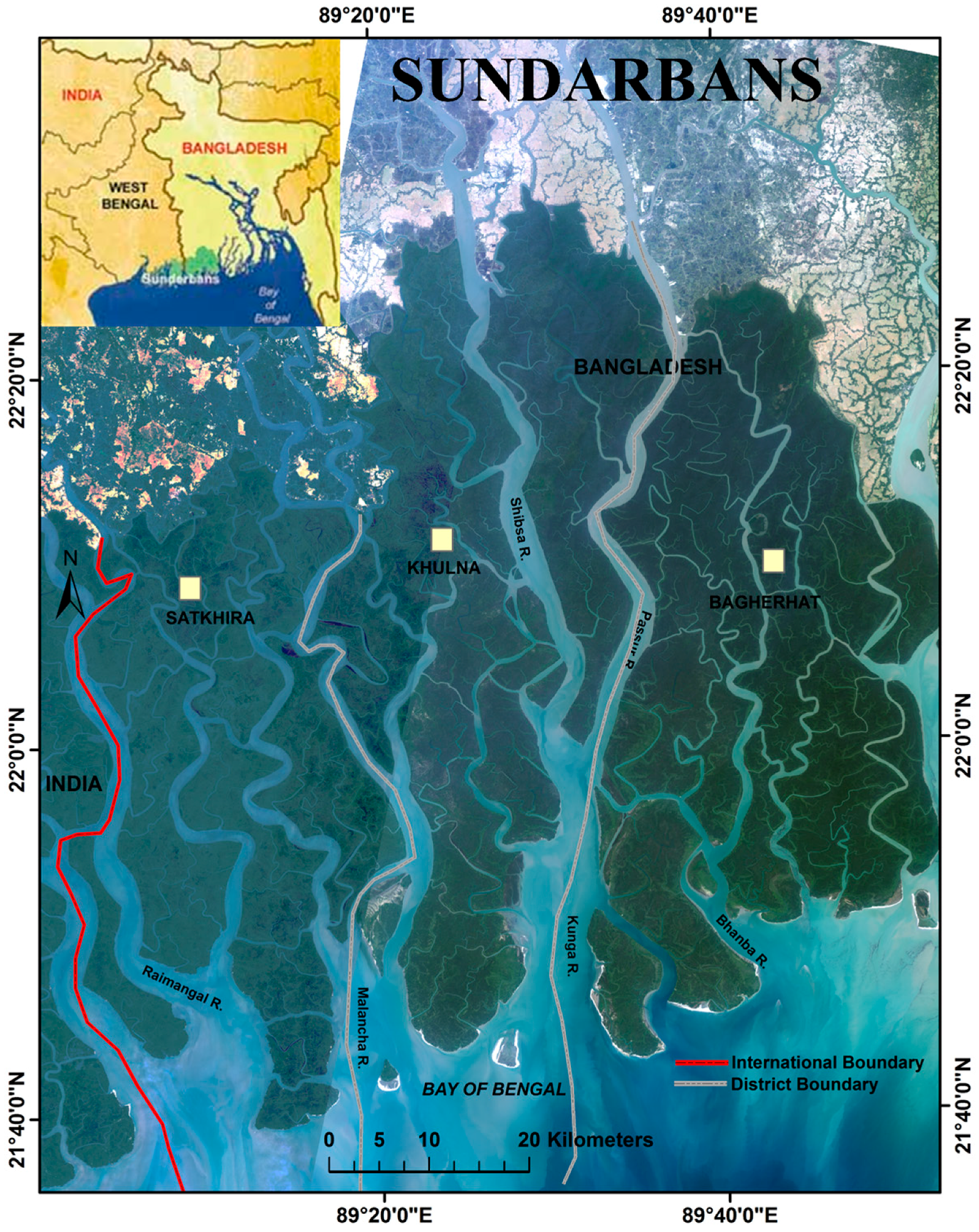
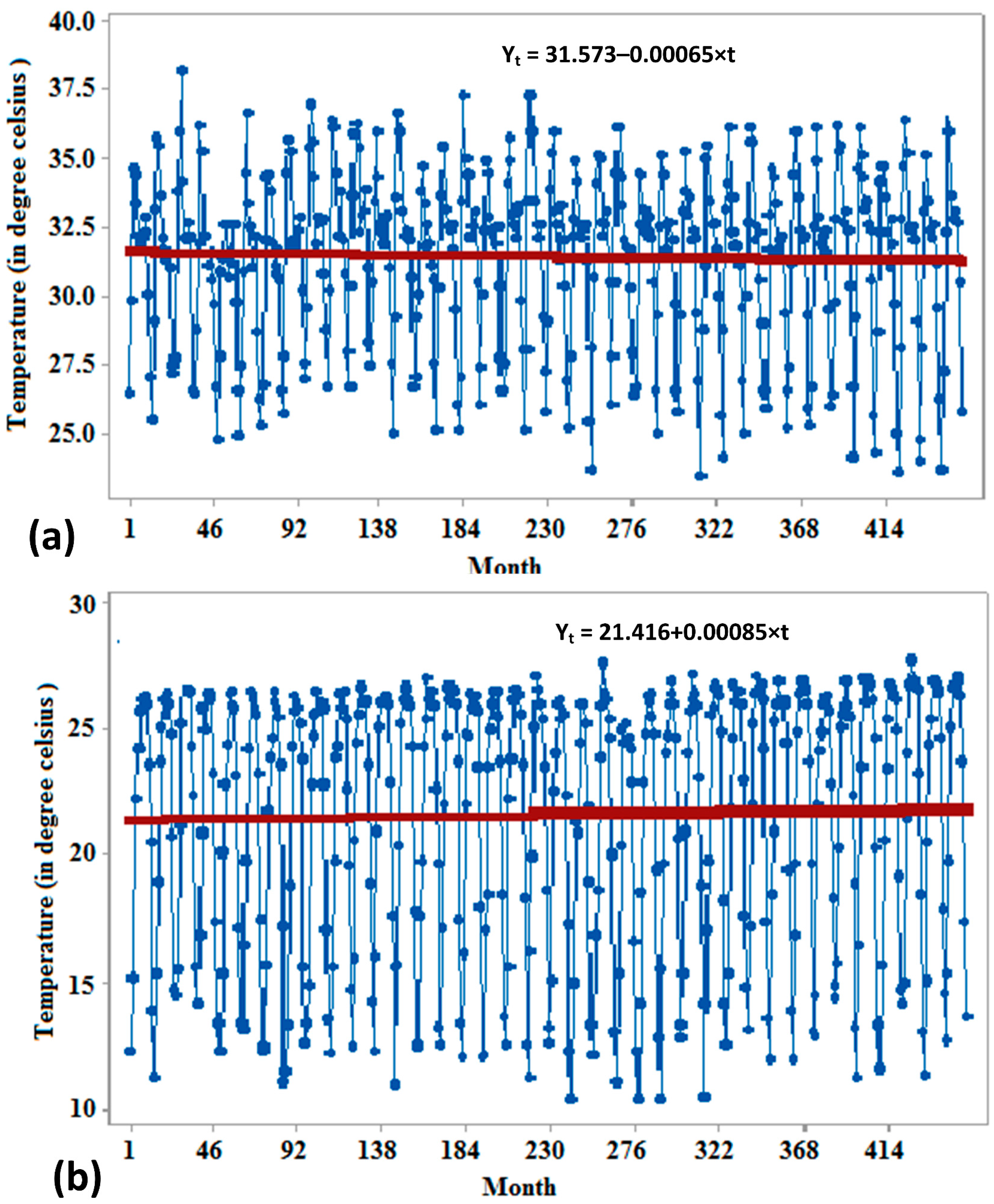
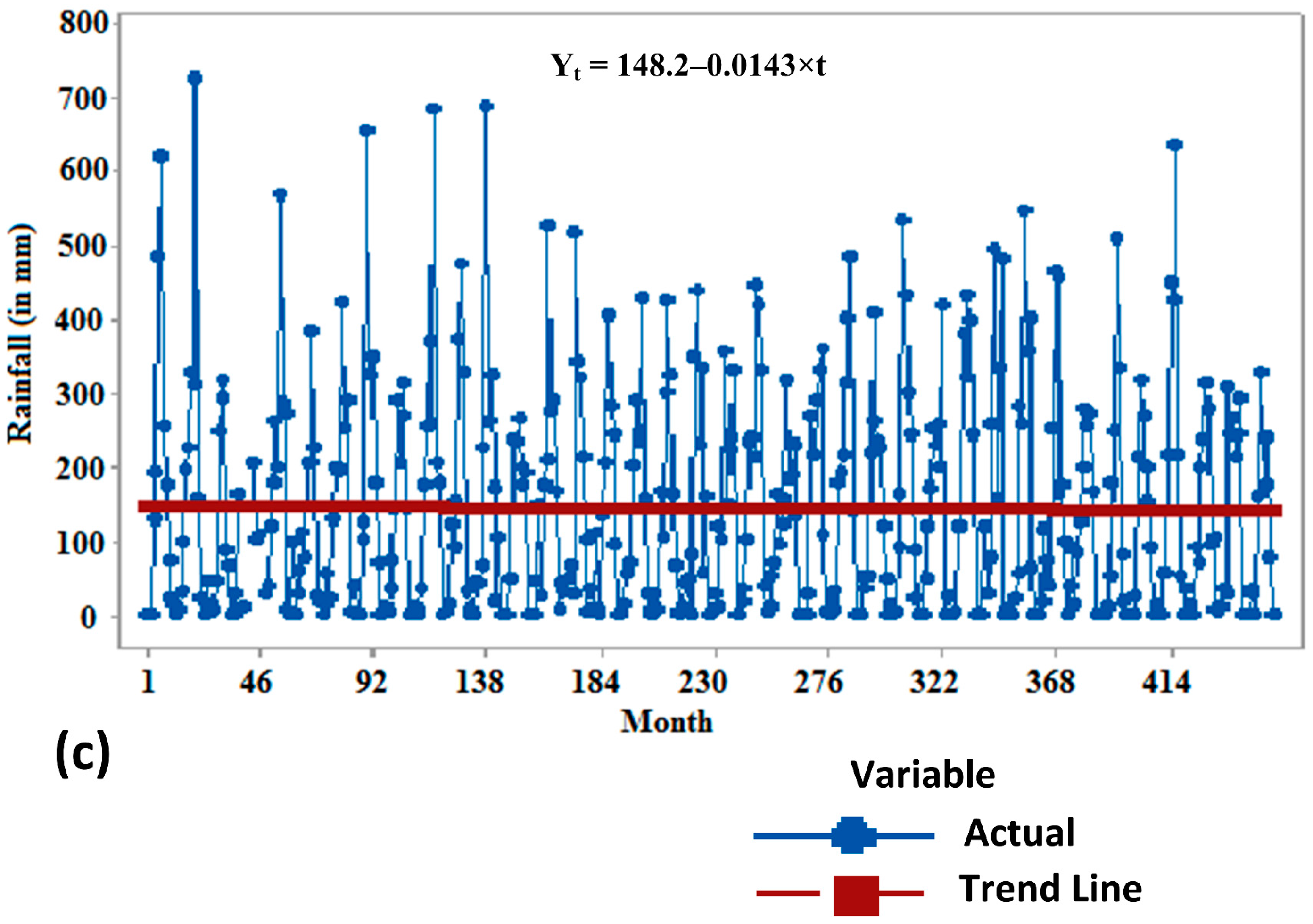
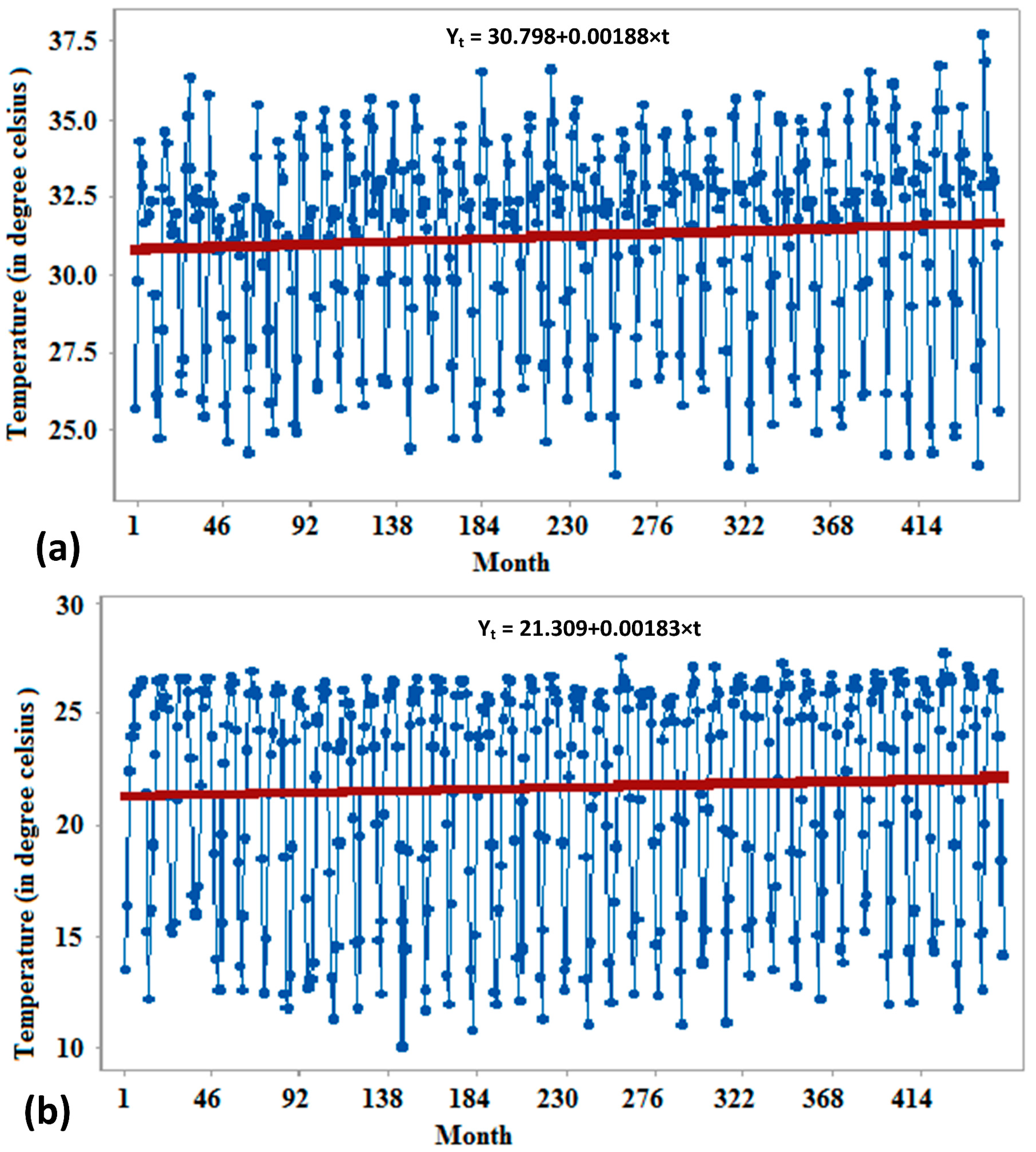
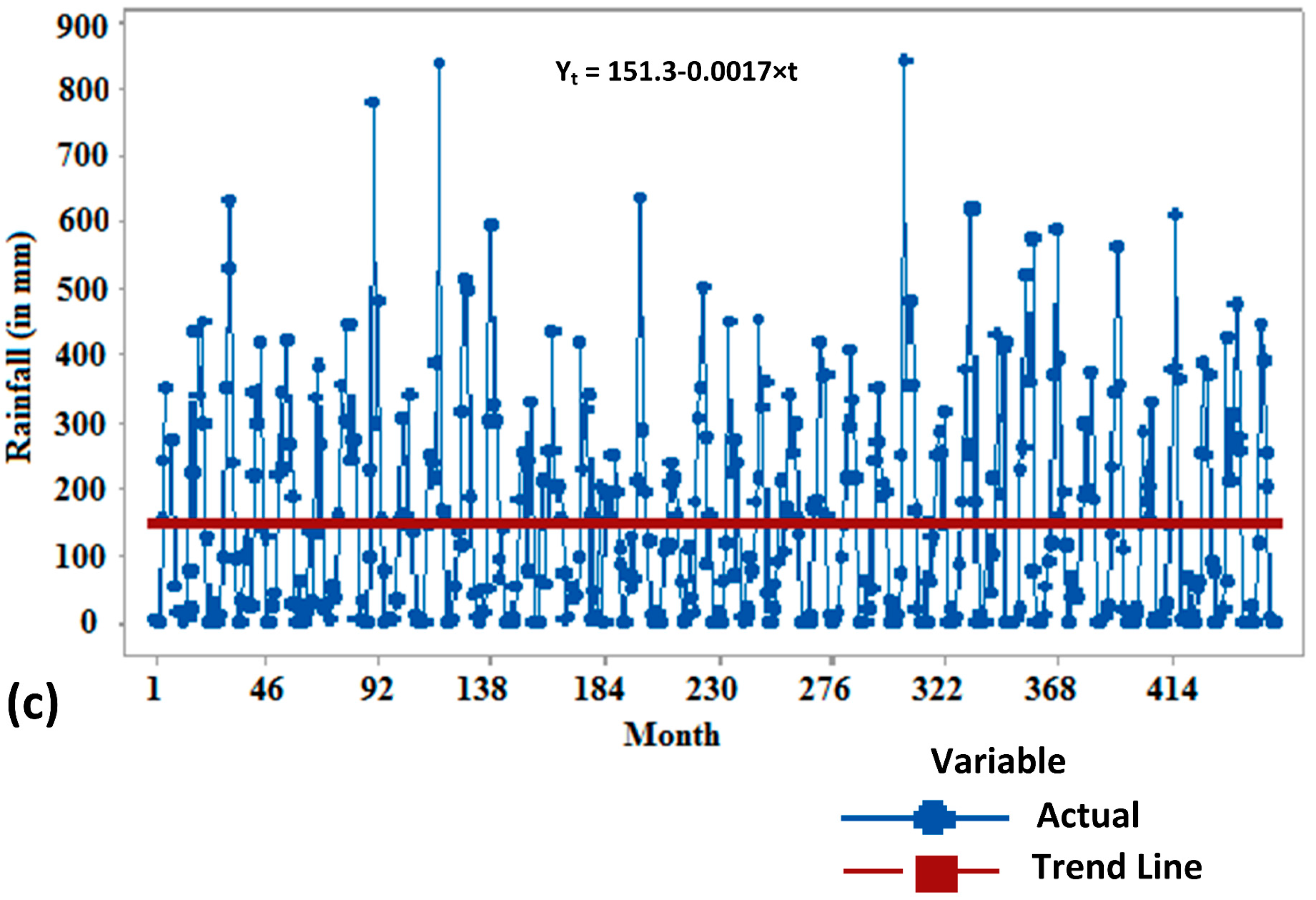
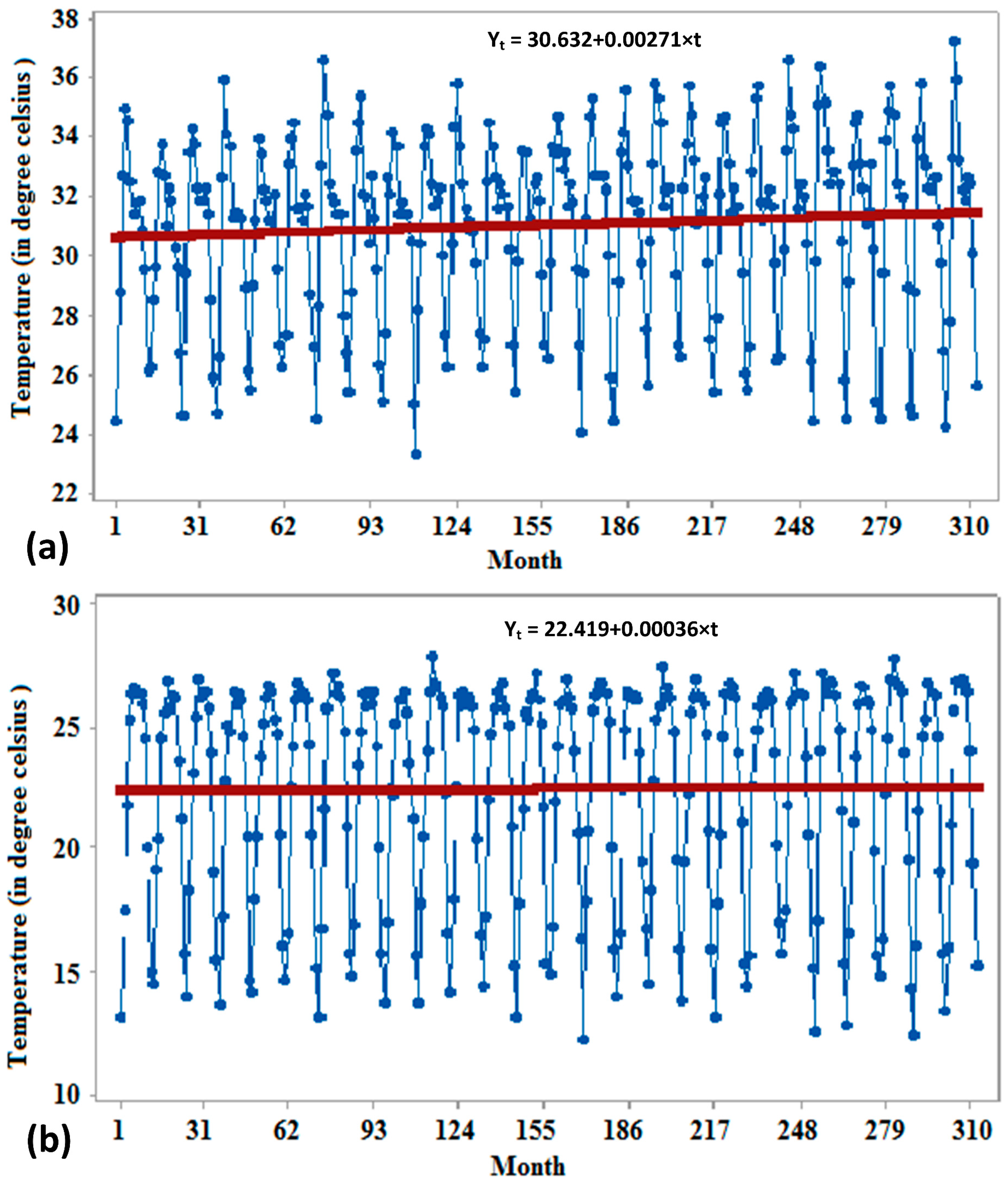
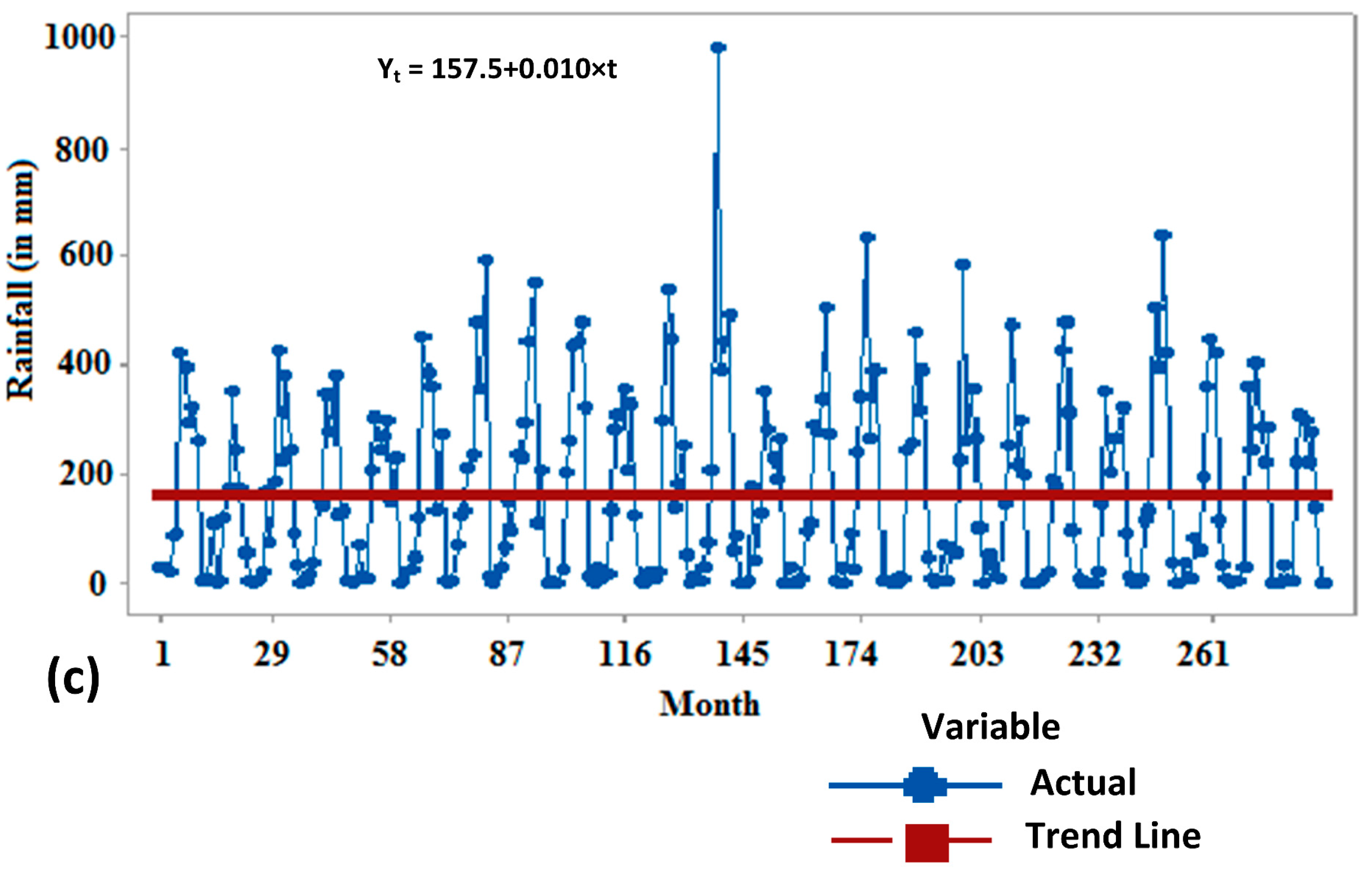

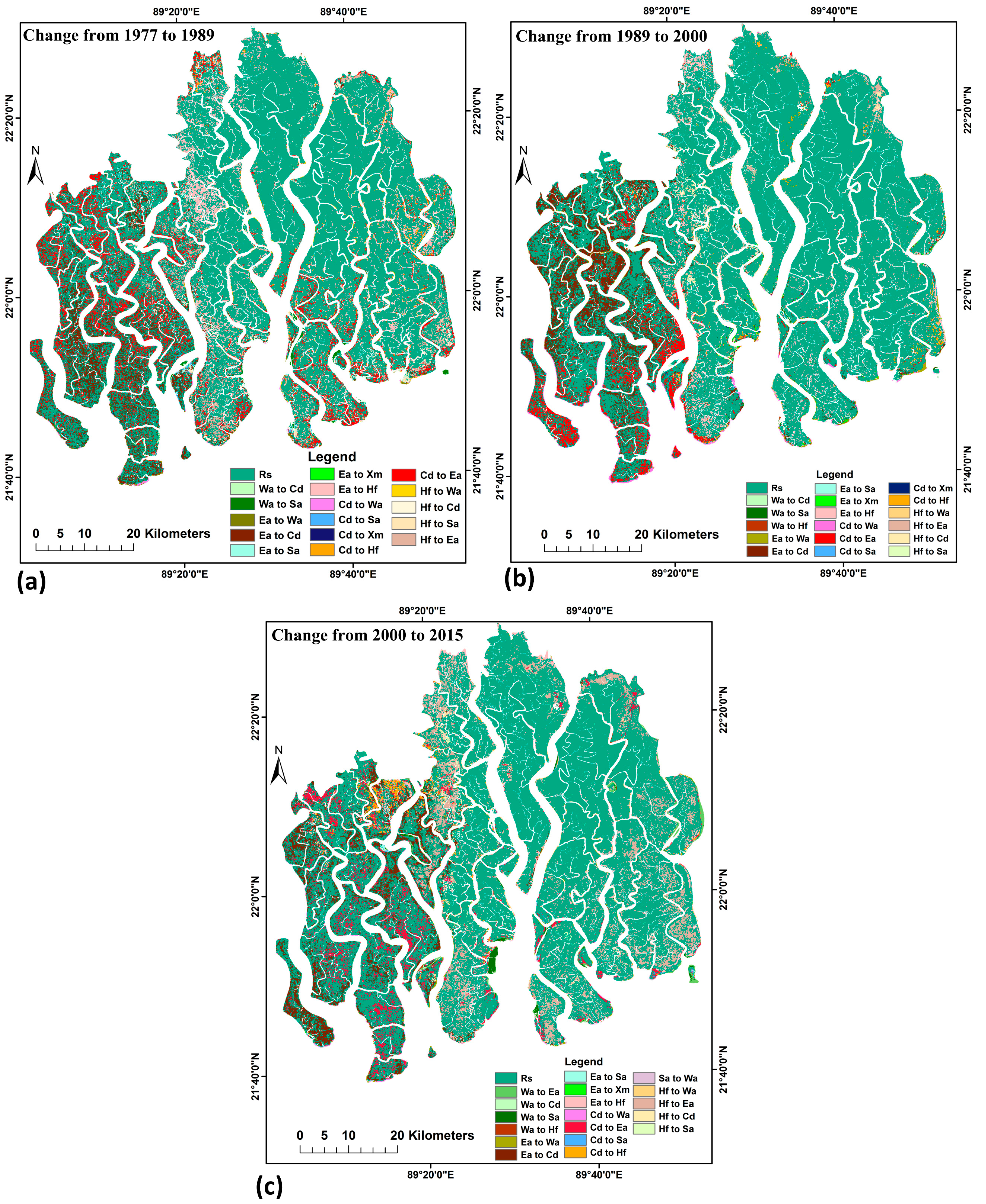
| Study Site | Time Period | Change Rate of Climatic Variables | ||
|---|---|---|---|---|
| Maximum Temperature (°C Per Year) | Minimum Temperature (°C Per Year) | Rainfall (mm Per Year) | ||
| Satkhira | 1977–1989 | +0.0763 | −0.0094 | −0.444 |
| 1990–2000 | −0.009 | −0.066 | +1.392 | |
| 2001–2015 | +0.0048 | +0.0247 | −2.184 | |
| Khulna | 1977–1989 | +0.0616 | −0.0502 | +0.588 |
| 1990–2000 | +0.0594 | +0.0552 | +1.308 | |
| 2001–2015 | +0.0226 | +0.0194 | −1.632 | |
| Bagherhat | 1990–2000 | +0.0302 | +0.0402 | +5.928 |
| 2001–2015 | +0.0132 | −0.0020 | −2.436 | |
| Study Site | Mangrove Species | Area in Hectares | Change in Area | Rate of Change % Per Year | |||||||||
|---|---|---|---|---|---|---|---|---|---|---|---|---|---|
| 1977 | 1989 | 2000 | 2015 | 1977–1989 | 1989–2000 | 2000–2015 | 1977–2015 | 1977–1989 | 1989–2000 | 2000–2015 | 1977–2015 | ||
| Satkhira | H. fomes | 4118 | 2940 | 1853 | 1114 | −1178 | −1087 | −739 | −3004 | −2.38 | −3.36 | −2.66 | −1.92 |
| E. agallocha | 58,611 | 54,956 | 45,002 | 40,270 | −3655 | −9954 | −4732 | −18,341 | −0.52 | −1.65 | −17.02 | −0.82 | |
| C. decandra | 41,760 | 45,484 | 53,343 | 59,346 | +3724 | +7859 | +6003 | +17,586 | +0.74 | +1.57 | +21.60 | +1.11 | |
| X. mekongensis | 503 | 798 | 1125 | 1134 | +295 | +327 | +9 | +631 | +4.89 | +3.73 | +0.03 | +3.30 | |
| S. apelatala | 93 | 765 | 718 | 875 | +672 | −47 | +157 | +782 | +60.22 | −0.56 | +0.56 | +22.13 | |
| Khulna | H. fomes | 106,498 | 104,366 | 98,769 | 89,486 | −2132 | −5597 | −9283 | −17,012 | −0.17 | −0.49 | −0.63 | −0.42 |
| E. agallocha | 30,086 | 28,313 | 28,590 | 36,331 | −1773 | +277 | +7741 | +6245 | −0.49 | +0.09 | +1.81 | +0.55 | |
| C. decandra | 3186 | 6017 | 6869 | 8956 | +2831 | +852 | +2087 | +5770 | +7.40 | +1.29 | +2.03 | +4.77 | |
| X. mekongensis | 206 | 250 | 355 | 280 | +44 | +105 | −75 | +74 | +1.78 | +3.82 | −1.41 | +0.95 | |
| S. apelatala | 2268 | 2385 | 2521 | 3760 | +117 | +136 | +1239 | +1492 | +0.43 | +0.52 | +3.28 | +1.73 | |
| Bagherhat | H. fomes | 109,002 | 110,143 | 112,762 | 105,490 | +1141 | +2619 | −7272 | −3512 | +0.09 | +0.22 | −0.43 | −0.08 |
| E. agallocha | 36,658 | 33,407 | 31,610 | 42,703 | −3251 | −1797 | +11,093 | +6045 | −0.74 | −0.49 | +2.34 | +0.43 | |
| C. decandra | 7103 | 7775 | 4195 | 2308 | +672 | −3580 | −1887 | −4795 | +0.79 | −4.19 | −3.00 | −1.78 | |
| X. mekongensis | 107 | 50 | 118 | 100 | −57 | +68 | −18 | −7 | −4.44 | +12.36 | −1.02 | −0.17 | |
| S. apelatala | 401 | 409 | 724 | 3986 | +8 | +315 | +3262 | +3585 | +0.17 | +7.00 | +30.04 | +23.53 | |
| Mangrove Species | Maximum Temperature | Minimum Temperature | Rainfall | |||
|---|---|---|---|---|---|---|
| p Value | R-Square | p Value | R-Square | p Value | R-Square | |
| H. fomes | 0.006 | 98.81% | 0.401 | 35.87% | 0.0001 | 99.90% |
| E. agallocha | 0.936 | 0.42% | 0.352 | 42.02% | 0.993 | 0.01% |
| C. decandra | 0.147 | 72.75% | 0.128 | 76.09% | 0.116 | 78.12% |
| X. mekongensis | 0.489 | 26.12% | 0.169 | 69.09% | 0.427 | 32.86% |
| S. apelatala | 0.001 | 99.84% | 0.406 | 35.33% | 0.002 | 99.59% |
© 2017 by the authors. Licensee MDPI, Basel, Switzerland. This article is an open access article distributed under the terms and conditions of the Creative Commons Attribution (CC BY) license (http://creativecommons.org/licenses/by/4.0/).
Share and Cite
Ghosh, M.K.; Kumar, L.; Roy, C. Climate Variability and Mangrove Cover Dynamics at Species Level in the Sundarbans, Bangladesh. Sustainability 2017, 9, 805. https://doi.org/10.3390/su9050805
Ghosh MK, Kumar L, Roy C. Climate Variability and Mangrove Cover Dynamics at Species Level in the Sundarbans, Bangladesh. Sustainability. 2017; 9(5):805. https://doi.org/10.3390/su9050805
Chicago/Turabian StyleGhosh, Manoj Kumer, Lalit Kumar, and Chandan Roy. 2017. "Climate Variability and Mangrove Cover Dynamics at Species Level in the Sundarbans, Bangladesh" Sustainability 9, no. 5: 805. https://doi.org/10.3390/su9050805






